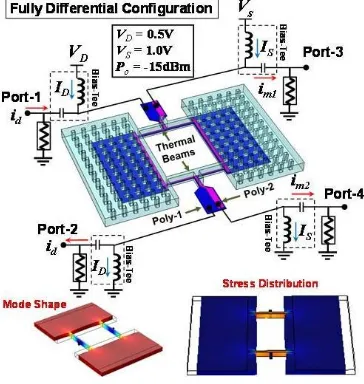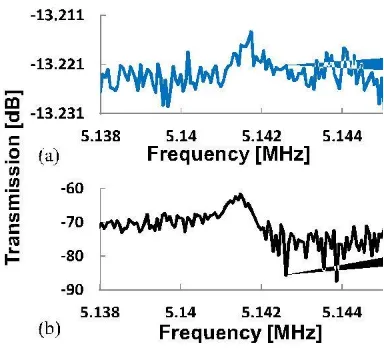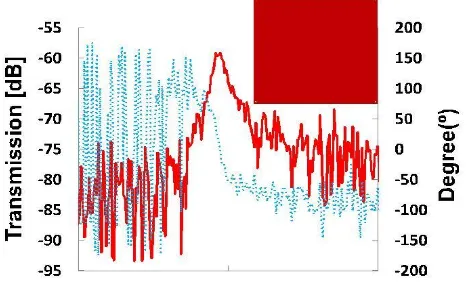S.Thenappan1, N.Porutchelvam2
1,2
Department of ECE, Gnanamani College of Technology, India
Abstract— The paper presents a novel resonant-microsensor platform for chemical and biological sensing
applications in gaseous and liquid environment. We report a thermally driven and piezoresistively sensed CMOS-microelectromechanical systems (MEMS) resonator with quality factor Q >15 000 and stopband rejection of 15 dB under CMOS-compatible bias voltage. Tha basic requirement of CMOS under the influence of this bias voltage. In addition, the combination of the bulk-mode resonator design and high- Q
SiO2/polysilicon structural material leads to resonator Q>15 000, a key index for low-phase-noise oscillators
and low-insertion-loss filters. The resonator with a center frequency at 7.1 MHz was fabricated using a standard 0.85 µm 3-poly-7-metal CMOS process, featuring low cost, batch production, fast turnaround time, easy prototyping, and MEMS/IC integration. To resolve the feedthrough issue often seen in conventional thermal-piezoresistive resonators: 1) separation of the heater and piezoresistor is first adopted because of the routing flexibility of the structural configuration offered by CMOS back-end-of-line materials and 5) fully differential measurement scheme is then applied to the proposed device, both of which enable a low-feedthrough level with 85-dB improvement as compared with its single-ended counterpart.
Index Terms— CMOS-MEMS, micro-resonators, piezoresistive device thermal stability, Q factor, thermo-elasticity, microelectro-mechanical system.
I. INTRODUCTION
THERMAL-PIEZORESISTIVE MEMS resonators recently attracted significant attention due to their simple design, easy fabrication, high Q, operation in air and liquid environment, and low actuation voltage [1]–[3]. The combination of thermal actuation and piezoresistive detection not only prevents the need for deep submicron gap spacing in capacitive transducers but also resolves exotic material issue caused by piezoelectric transducers, which becomes a simple and effective transduction mechanism using mere resistors. The main structural materials of these resonators are silicon carbide or single crystal silicon to attain high Q while the heater for driving and piezoresistor for sensing are formed using either the same structural materials via doping [2], [3] or deposited metal layers [1]. However, none of the prior literature addresses the practical integration with circuits
Fig. 1. Perspective-view schematic of a CMOS-MEMS bulk mode resonator driven by a resistive heater and sensed through a piezoresistor. The heater and piezoresistor are embedded inside a high-Q SiO2
to deploy their implementations on sensing and frequency control applications. Thanks to the recent advance on CMOS-MEMS technology through which MEMS resonators can be monolithically integrated with amplifier circuits to realize single-chip configuration [4], the thermal-piezoresistive resonators could also be realized through CMOS BEOL materials, demonstrated in our previous work [5].
To perform differential testing for feedthrough cancellation, the design of our first prototype [5] is rather involved (i.e., array design) and the characterization still necessi-tates de-embedding and post-data processing to extract the motional signal, which is not practical for real application. In addition,
Q (lower than 1,000) and signal intensity of the resonator is limited due to the improper choice of the CMOS BEOL materials.
In this letter, we explore the material properties of the polysilicon layers offered by a 0.35 μm 2P4M CMOS tech-nology node for the heater and sensor, both of which are embedded inside a
high-Q SiO2 (i.e., CMOS dielectrics) vibrating dog-bone resonator as shown in Fig. 1. With (i) decoupling
scheme of the heater and sensor and (ii) proper selection of their materials, the resonator can be operated in with decent resonance performance and low feedthrough floor (∼40-dB improvement). To go one step further, a fully differential testing configuration can be carried out through a simple dog-bone structure thanks to the routing flexibility of the CMOS-MEMS resonators, hence leading to additional feedthrough rejection of more than 30 dB as compared to its single-ended counterpart.
II. DEVICE DESIGN AND OPERATION
To overcome the high feedthrough level often seen in thermal-piezoresistive resonators where the resistor serves as both heater and sensor, a decoupling scheme of heating and sensing elements is adopted as shown in Fig. 1 to prevent the resistive feedthrough. A low-loss structural material from the dielectric (i.e., SiO2) layers of CMOS BEOL yields (i) high Q for mechanical vibration, (ii)
electrical insulator for embedded heater and sensor routing. Based on the material properties of the two polysilicon layers from the foundry, poly-1 layer, originally acting as gate polysilicon for tran-sistors, possesses low resistance and high current density capability. It is suitable for heater operation. In contrast, poly-2 layer, serving as resistors in IC, features high gauge factor, which is well suited for the use as piezoresistors. To operate the resonator in Fig. 1, one dc current (ID) flows
through poly-1 heater to generate biasing for thermal drive while another dc current (IS ) is applied
into poly-2 sensor to provide resistive readout. Such a design enables single-ended, single-to-differential, differential-to-signal, and fully differential test configurations, thus allowing us to explore the optimized operation of the device. A fully-differential scheme is illustrated here to explain the working principle of the proposed device. The combination of an ac input id (induced by
vin+ of port-1 and vin− of port-2 from a network analyzer) and dc biasing ID generates a time-varying
thermo-elastic force to excite the resonator into resonance with a mode shape shown in the inset of Fig. 1. Then the stress/strain modulated by the mechanical vibration of the thermal beams and further enhanced by the end proof-masses induces resistance change of the embedded piezoresistors, which can be sensed by vout + of port-3 and vout − of port-4 in the network analyzer. The common-mode
noise would be either circulated in the input loop from vin+ to v in− or cancelled by the differential
readout of vout + and vout −, therefore significantly reducing the feedthrough floor. The differential
structure ideally is about 6 μm.
To characterize the resonator, the device was placed in a vacuum chamber with an electrical setup shown in Fig. 1 where different configurations can be performed, including (i) conventional single-ended scheme (i.e., one-port) with the heater and sensor using the same polysilicon layer,
Fig. 2. Photos of a fabricated CMOS-MEMS thermal-piezoresistive resonator, including (a) global MEMS/IC optical view, (b) standalone device SEM view, and (c) FIB cut cross-sectional view of the beam.
(ii) two-port scheme with decoupled heater and sensor using different polysilicon layers, (iii) common-mode driving and differential sensing, and (iv) fully differential scheme. Fig. 3(a) presents the measured transmission characteristic of a conven-tional one-port configuration using port-1 as the driving input and port-2 as the sensing output, all under the poly-1 layer. The measured result shows a very high floor at −13.21 dB caused by the resistive feedthrough, indicating the motional signal of the resonance is significantly masked. Therefore, the one-port configuration of the thermal- piezoresistive resonator often necessitates a post-data processing to extract the motional signal [3]. To overcome the feedthrough issue, in contrast to the previous single crystal silicon resonators [3], the material
Fig. 4. Measured transmission spectrum under a fully differential measurement configuration depicted in Fig.
1. The insertion loss, 58.5 dB, is referenced to the 50Ω network analyzer port impedance.
Fig.5 Thermal stability measurement under various operation
TABLE I
performance is well sufficient to drive the resonator into vibration. The dc-bias VD on the heater and
VS on the piezoresistor are only 0.5 V and 1 V, respectively, thus leading to the total dc power
consumption of about 1.25 mW. The measured signal feedthrough floor in this case improves 33 dB as compared To the two-port decoupled scheme of Fig. 3(b), exhibiting a clean resonance with Q of 11,916. Table I provides a comparison of state-of-the-art CMOS-MEMS resonators with various transductions.
Finally, the thermal stability measurement of the devices was performed with results shown in Fig. 5. Since the operation scheme requires the dc-bias currents ID and IS through the heater and
piezoresistor for driving and sensing, the heating power varies due to the temperature coefficient of resistance (TCR ) of the polysilicon heater. Constant voltage/ current schemes were applied on the
polysilicon layer, showing that the constant voltage approach provides better thermal stability due to its positive TCR . To further improve the thermal stability, the constant resistance technique [5] was
also employed with TCf of only −8.46 ppm/K.
IV. CONCLUSION
This letter demonstrates a thermally actuated and piezore-sistively sensed CMOS-MEMS resonator under very low dc voltage operation. With a fully differential measure-ment scheme, the resonance peak is clearly resolved in the transmission measurement without the need for de-embedding of the feedthrough signal. As compared to the capacitive type CMOS-MEMS resonators, this letter offers a CMOS-compatible bias configuration (no need for charge pump), which paves the way for the future integrated thermal-piezoresistive oscillators particularly in sensor applications.
REFERENCES
[1] I.Bargatin, I.Kozinsky, and M.L.Roukes, ― Efficient electrothermal actuation of multiple modes of high-frequency
nano electromechanical resonators,‖Appl.Phys.Lett, Vol.90, no.9.p.093116, 2007
[2] J.H.Seo and O.Brand, ―High Q-factor in plane moderesonant microsensor platform for gaseous/liquid environment,‖J. Microelectromech. Syst. , vol. 17, no. 2, pp. 483–493, Apr. 2008.
[3] A. Rahafrooz and S. Pourkamali, ―High-frequency thermally actuated electromechanical resonators with
piezoresistive readout,‖ IEEE Trans. Electron Devices , vol. 58, no. 4, pp. 1205–1214, Apr. 2011.
[4] A. Rahafrooz and S. Pourkamali, ―High-frequency thermally actuated electromechanical resonators with
piezoresistive readout,‖ IEEE Trans.Electron Devices , vol. 58, no. 4, pp. 1205–1214, Apr. 2011.
[5] C.-C. Chen et al., ―Enhancement of temperature stability via constant-structural-resistance control for MEMS resonators,‖ in Proc. IEEE 26th Int. Micro Electro Mech. Syst. Conf. , Taipei, Taiwan, Jan. 2013,pp. 765–768. [6] J. T. M. van Beek, P. G. Steeneken, and B. Giesbers, ―A 10 MHz piezoresistive MEMS resonator with high Q,‖ in
Proc. IEEE IFCS,Miami, FL, USA, Jun. 2006, pp. 475–480.
[7] E. Marigo et al., ―Zero-level packaging of MEMS in standard CMOS technology,‖ J. Micromech. Microeng. , vol. 20, no. 6, p. 064009,Jun. 2010


